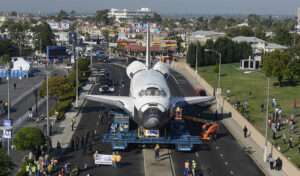After completing 25 missions, the Space Shuttle Endeavour was retired from service in May 2011. More than 20 organizations submitted proposals to NASA for the display; the California Science Center in Los Angeles was selected to receive it. Endeavour was mounted on the shuttle carrier aircraft and departed from the Kennedy Space Center on September 19, 2012, and delivered to the Los Angeles International Airport on September 21st. Upon arrival, a welcome ceremony was held for the shuttle and then prepared for its final trip through the streets of Los Angeles. Transporting it through one of the county’s largest cities was a major logistical undertaking with significant civil engineering challenges and national media attention.
|
Cordoba Corporation was an integral part of a team of consultants selected by officials of the California Science Center contributing their expertise and resources to assist the California Science Center in the planning, engineering, and execution of the historical transport of the shuttle. Multiple organizations and government agencies were involved in this major logistical undertaking, which also included public outreach and events. The transport also presented a series of significant engineering challenges. A route was selected that minimized obstacles, but all utility poles, buildings, medial strips, curbs and trees could not be avoided. Potential issues included overhead lines and underground utilities that required load analysis. For example, the selected alignment crossed electrical systems that were directly connected to LAX operations including air traffic control. The sheer weight of the shuttle (nearly 400,000 lbs. including carriage) had the potential to have a serious impact on roadways and underground utilities.
Cordoba Corporation performed field verification of all obstructions to determine a route that minimized the impact on utilities and the surrounding communities. As a result of Cordoba’s extensive field review and analysis, a path was developed that decreased the number of items that needed to be cleared by 50 percent. The Cordoba team was responsible for in-field coordination, design, construction oversight, and coordination of the temporary removal of street services along the route, which all had to be restored within eight hours after the event.
The move was a nationally televised event scrutinized by the media and involved over a million people who lined the streets of Los Angeles to witness this awe-inspiring move. The fact that the entire mission went off as planned is significant and a testament to Cordoba’s abilities to provide engineering and planning services that consider a myriad of complexities, numerous stakeholders and the local community. Our staff was recognized by the California Science Center, mayors of the Cities of Los Angeles and Inglewood, the California Legislature and Engineering News-Record Magazine for the planning and execution of the historic move. We collaborated with the LADWP, Los Angeles World Airports (LAWA), the Los Angeles and Inglewood Civil Authorities, NASA, Caltrans, LA Metro, AT&T, Time Warner, other telecom companies, as well as area residents and many other affected parties.
The following year, a gas tank joined the display at the Science Center. ET-94 (the external tank’s formal name) traveled from NASA’s assembly facility in New Orleans through the Panama Canal by barge to Los Angeles and through city streets, on a route designed by Cordoba Corporation engineers to its final destination. ET-94’s 16.5-mile route from Marina Del Rey through the streets of Los Angeles to the California Science Center took a year of planning by many hard-working Cordoba engineers.
|


